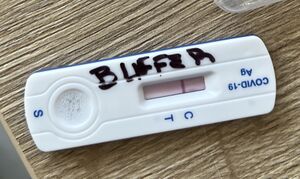Difference between revisions of "How do controls on antigen COVID tests work?"
(create page) |
m |
||
| Line 1: | Line 1: | ||
{{Project Infobox|Self researchers=Paulina Ejsmont, Maira Goytia, Tim Dobbs, Yann Huon de Kermadec, User:Gedankenstuecke|Related tools=COVID tests}} | {{Project Infobox|Self researchers=Paulina Ejsmont, Maira Goytia, Tim Dobbs, Yann Huon de Kermadec, User:Gedankenstuecke|Related tools=COVID tests}} | ||
| − | There are a large number of different rapid [[COVID tests]], both for professionals but also for self-testing at home. Beyond the actual test indicator, these tests also contain a ''control'' indicator that should appear regardless of whether COVID was detected or not. During the [[2022-04-28 Self-Research Chat|self-research chat on April 28]] the question of how these controls work came up | + | There are a large number of different rapid [[COVID tests]], both for professionals but also for self-testing at home. Beyond the actual test indicator (shown by the '''''T''''' line on the test), these tests also contain a ''control'' indicator (shown by the '''''C''''' line on the test) that should appear regardless of whether COVID was detected or not. |
| + | |||
| + | During the [[2022-04-28 Self-Research Chat|self-research chat on April 28]] the question of how these controls work came up. Do they indicate that the person taking the test did correctly swab their nose to take a sample? Or do they only indicate that the test itself was correctly loaded and that liquid is present? | ||
To solve this question we did a small experiment using a regular COVID test for home-use. | To solve this question we did a small experiment using a regular COVID test for home-use. | ||
Revision as of 08:05, 4 May 2022
| Project Infobox | |
|---|---|
| Self researcher(s) | Paulina Ejsmont, Maira Goytia, Tim Dobbs, Yann Huon de Kermadec, User:Gedankenstuecke |
| Related tools | COVID tests |
| Related topics | |
Builds on project(s) |
|
| Has inspired | Projects (0) |
There are a large number of different rapid COVID tests, both for professionals but also for self-testing at home. Beyond the actual test indicator (shown by the T line on the test), these tests also contain a control indicator (shown by the C line on the test) that should appear regardless of whether COVID was detected or not.
During the self-research chat on April 28 the question of how these controls work came up. Do they indicate that the person taking the test did correctly swab their nose to take a sample? Or do they only indicate that the test itself was correctly loaded and that liquid is present?
To solve this question we did a small experiment using a regular COVID test for home-use.
Experiment #1: Loading the test with only the provided buffer liquid
If the control on the rapid COVID test were to identify that the user correctly swabbed their nose, it should detect some molecules that are universally present in the human nose. Conversely, in this case the control line should not appear if the test is only loaded with the buffer liquid that is part of the test kit without having performed any swabbing.
To test this, we loaded a antigen COVID test using only the buffer liquid without performing any swabbing. Within a few seconds after loading the test the control line appeared.
Result
The control line that appears on a rapid COVID test does not indicate that one has correctly taken a sample, it only indicates that one loaded the test correctly.
Linked content on this wiki
(The content in the table below is automatically created. See Template:Project Queries for details. If newly linked pages do not appear here, click on "More" and "Refresh".)
| Project that build on this project |
|---|
| We talked about this project in the following meetings |
|---|
| 2022-05-05 Self-Research Chat |
